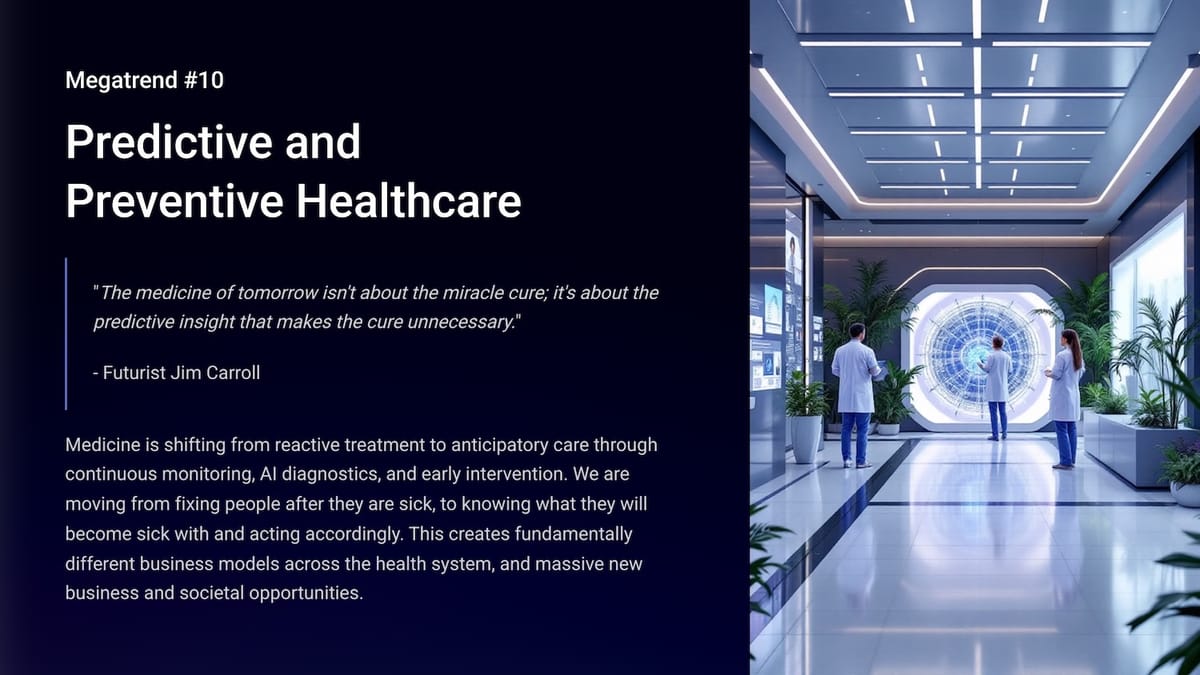"The medicine of tomorrow isn't about the miracle cure; it's about the predictive insight that makes the cure unnecessary." - Futurist Jim Carroll
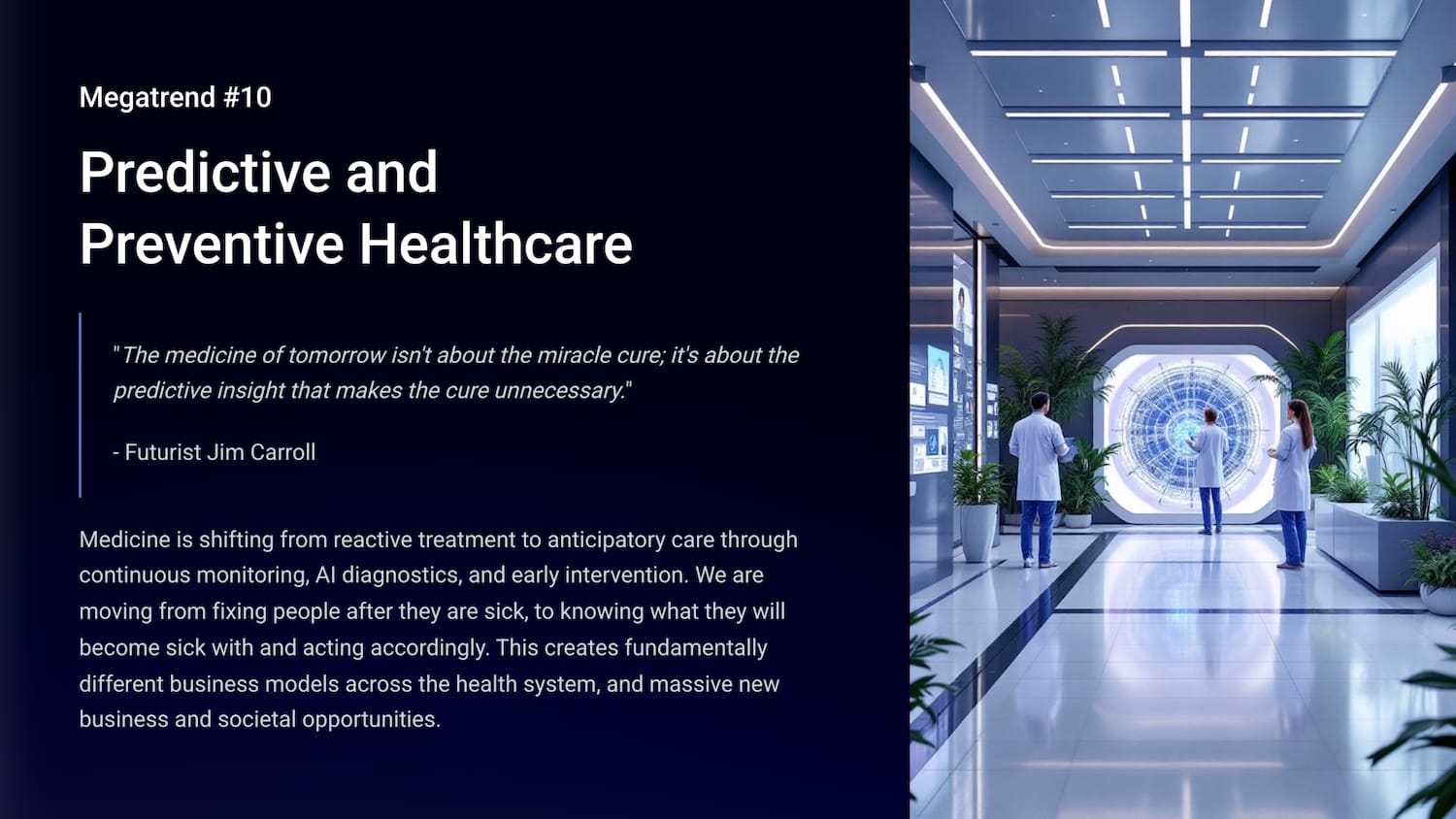
(Futurist Jim Carroll is writing a series on 30 Megatrends, which he first outlined in his book Dancing in the Rain: How Bold Leaders Grow Stronger in Stormy Times. The trends were shared in the book as a way of demonstrating that, despite any period of economic volatility, there is always long-term opportunity to be found. The book is now in print - learn more at dancing.jimcarroll.com)
Medicine is shifting from reactive treatment to anticipatory care through continuous monitoring, AI diagnostics, and early intervention. We are moving from fixing people after they are sick to knowing what they will become sick with and acting accordingly. This creates fundamentally different business models across the health system and massive new business and societal opportunities.
The interesting thing about this trend is that while it involves so much promise, it also requires societies that have a mature relationship with science and the future. Given some of the recent events throughout the US, it is becoming obvious that other parts of the world will see greater advancements with this megatrend, and so you need to consider all this from a global perspective. As I said yesterday, long-game proponents know, though, that megatrends always outlast the bombast, particularly at a global scale. With that in mind, let's dive into the idea of "health reimagined.". Want the full report? There's a PDF here!
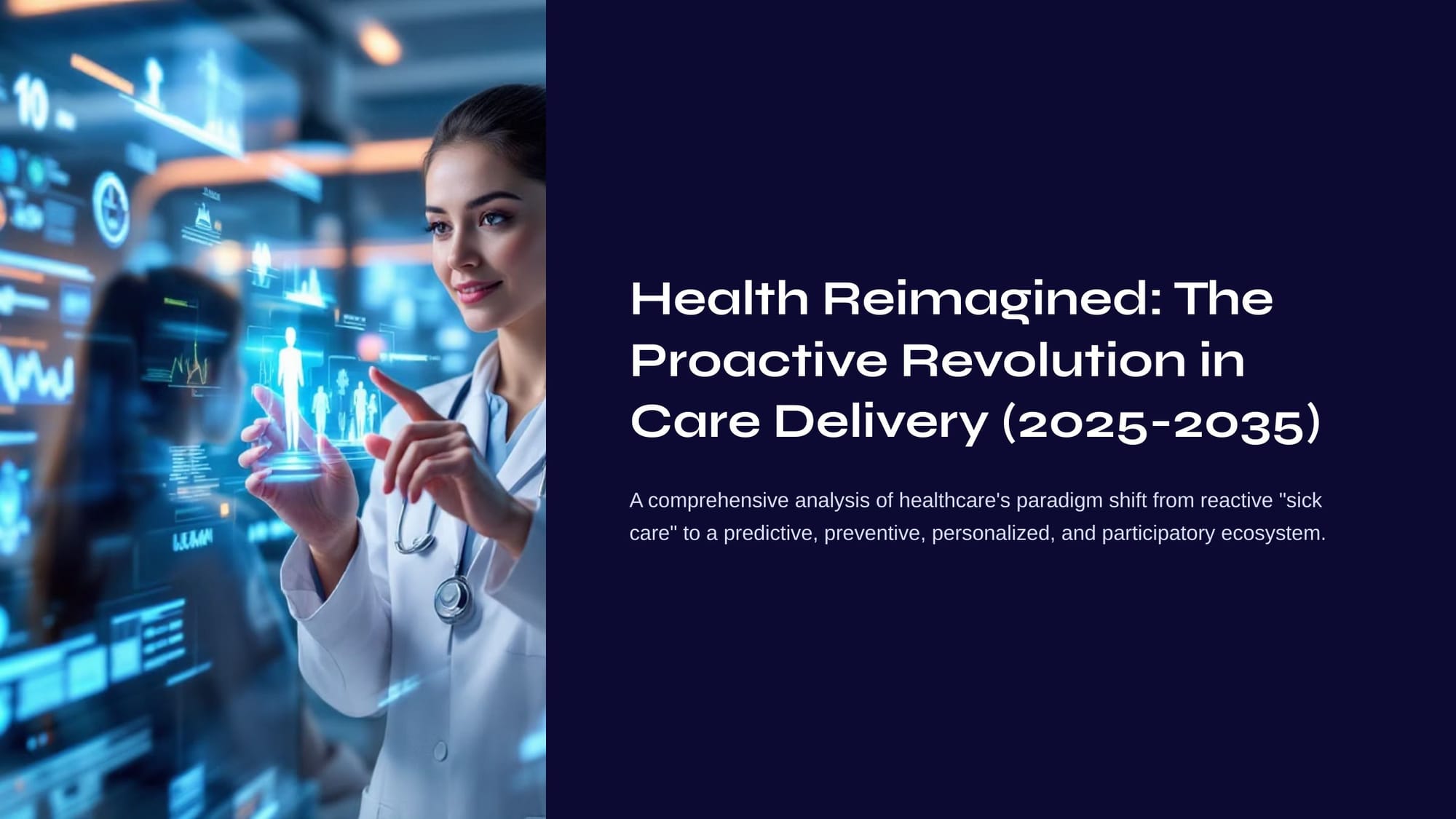
That said, let's start here with some numbers - globally, the healthcare system is at a crisis point, and so many realize that there are tremendous opportunities in a healthcare paradigm shift from reactive “sick care” to a predictive, preventive, personalized, and participatory ecosystem.
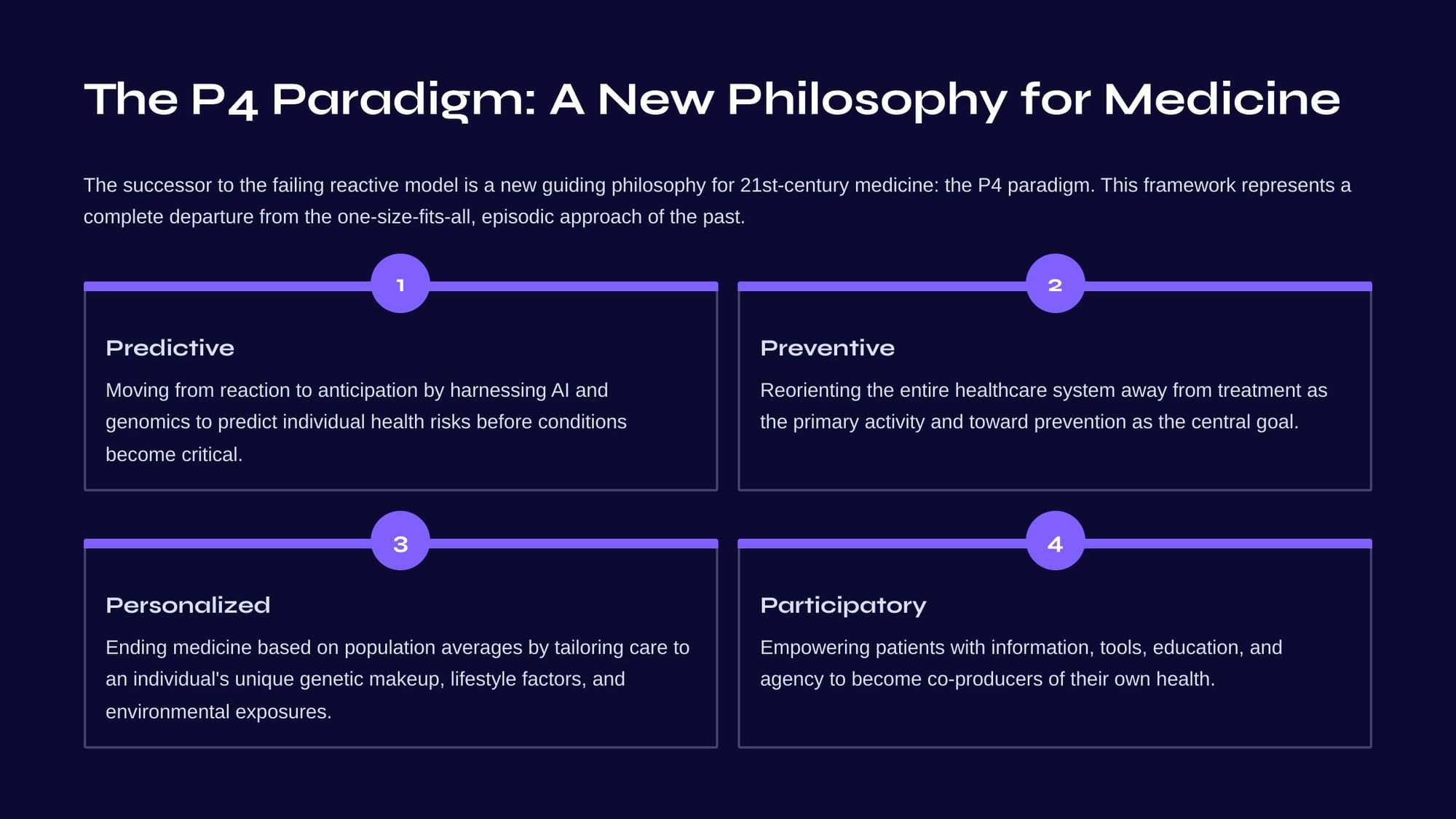
What's underneath it all are four major trends that form the central nervous system of a proactive health ecosystem.
- Artificial Intelligence: The engine of the proactive health revolution, enabling risk prediction, diagnostic enhancement, and personalized care at an unprecedented scale.
- Genomics: The biological blueprint for personalized medicine, enabling a shift from population averages to truly individualized care.
- Wearables & IoMT: The continuous monitoring network that captures real-time physiological and behavioral data in everyday life.
- Data Interoperability: The connective tissue that enables seamless information flow across the entire health ecosystem.
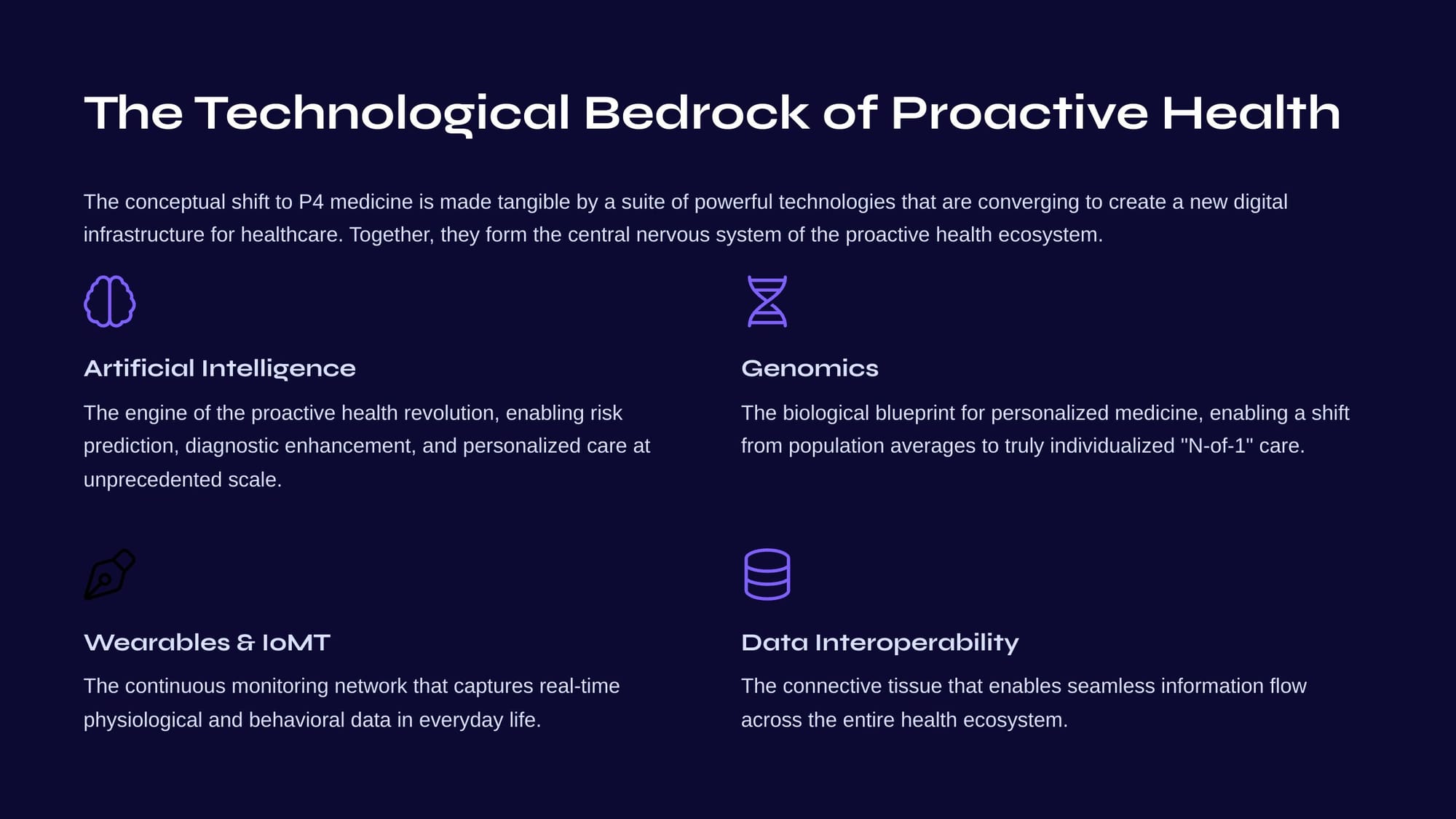
Artificial intelligence will become the undisputed engine of the proactive health revolution. Its role extends far beyond diagnostics to become the core processing unit for the entire ecosystem of massive amounts of data and insight. The spending will be immense - the global AI in healthcare market is projected to undergo explosive growth, expanding from an estimated USD 36.96 billion in 2025 to USD 613.81 billion by 2034, representing a compound annual growth rate (CAGR) of 36.83%!
The role is multi-faceted:
- Diagnostic Enhancement: AI algorithms reduce diagnostic errors by up to 30% in radiology and transform fields like pathology and dermatology.
- Predictive Analytics: AI analyzes vast datasets to identify at-risk individuals and populations, enabling proactive intervention.
- Workflow Automation: AI-powered scribes and virtual assistants automate administrative tasks, giving clinicians up to 20% more time for direct patient care.
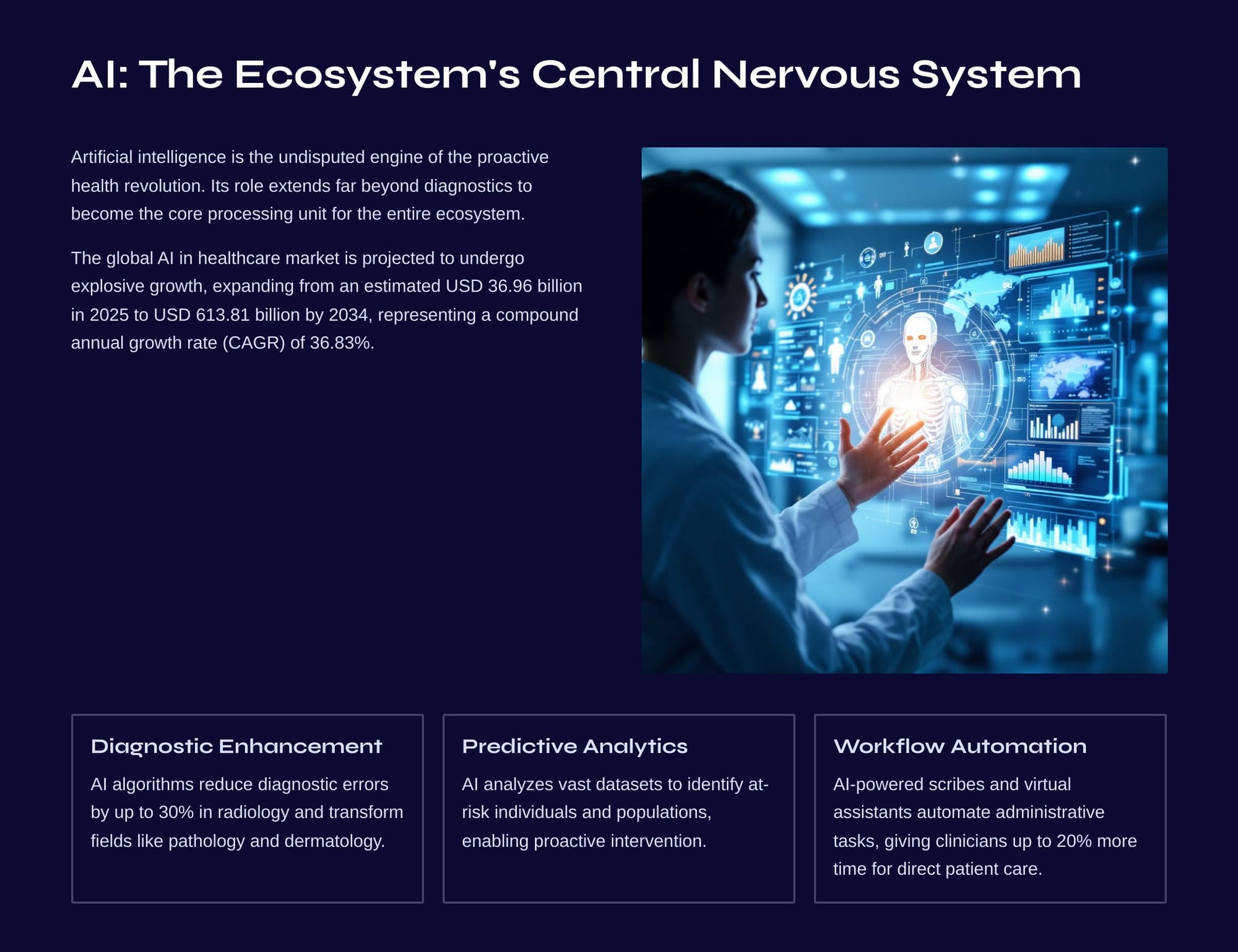
The second pillar is the "Genomic Revolution" - moving from a world where we treat patients based on their unique genomic profile. If AI is the ecosystem’s brain, genomics provides its unique biological blueprint. The genomic revolution is the key to unlocking true personalization in medicine.
The primary catalyst is the plummeting cost of genetic sequencing. What was once a complex and expensive research endeavor is rapidly becoming a mainstream clinical utility, with whole-genome sequencing now available for as low as $600. The personalized medicine market is projected to expand from USD 654.46 billion in 2025 to USD 1.31 trillion by 2034. Simply put, it's going to become extremely inexpensive to figure out the unique medical profile of each patient and deliver care accordingly.
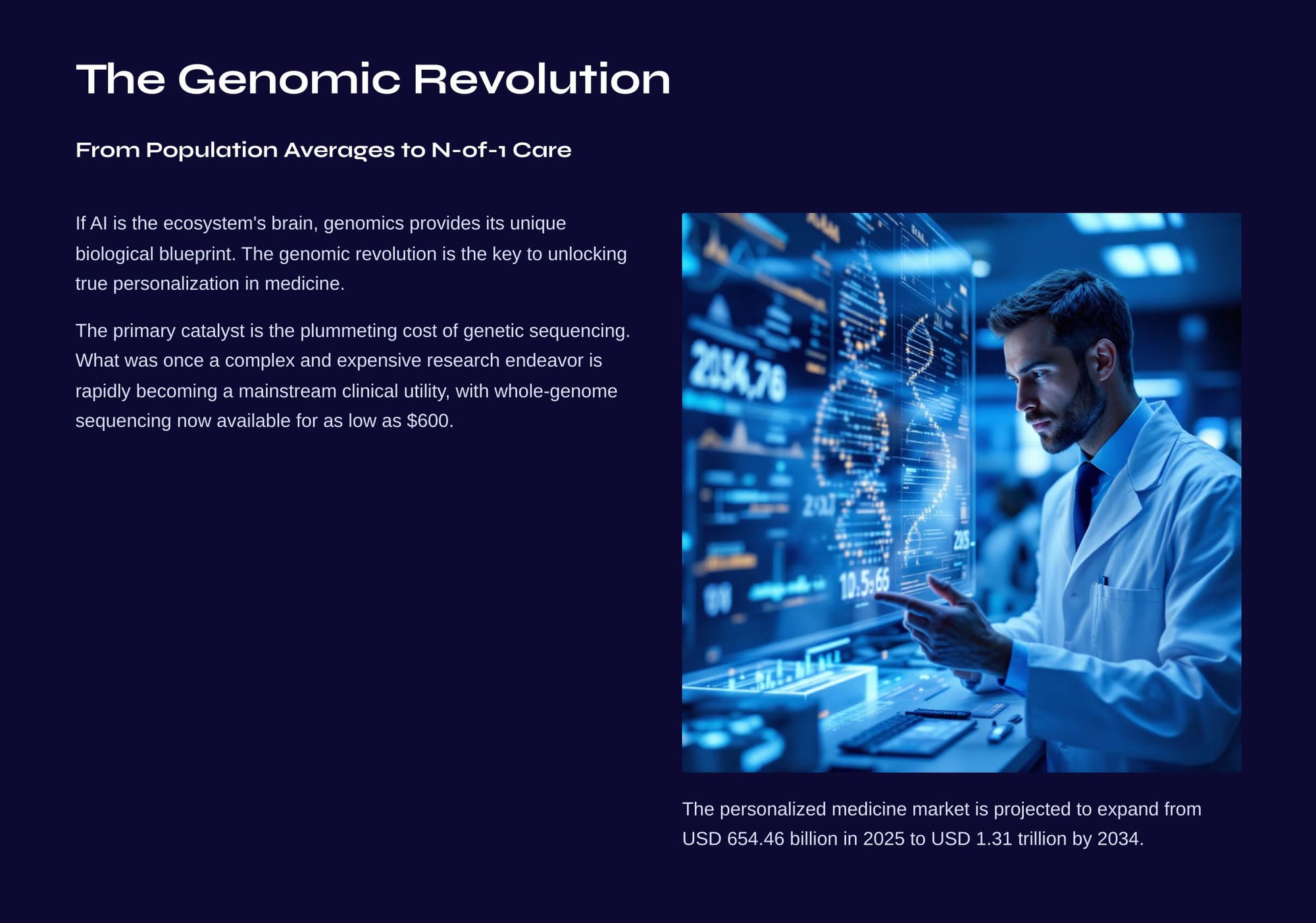
The third trend is the "sentient self which involves wearables & the Internet of Medical Things (IoMT). You'll remember I covered this just a few weeks ago with a keynote I gave on the topic. This involves a vast network of sensors that capture real-time, continuous data about an individual’s physiology and behavior.
This ecosystem of consumer wearables and clinical-grade Internet of Medical Things (IoMT) devices will fundamentally change the nature of health data itself, transitioning from momentary snapshots of patient health during infrequent clinical visits to a continuous, high-fidelity stream of real-world information. By 2022, 46% of U.S. consumers reported owning a wearable device, with adoption growing fastest among older and lower-income demographics.
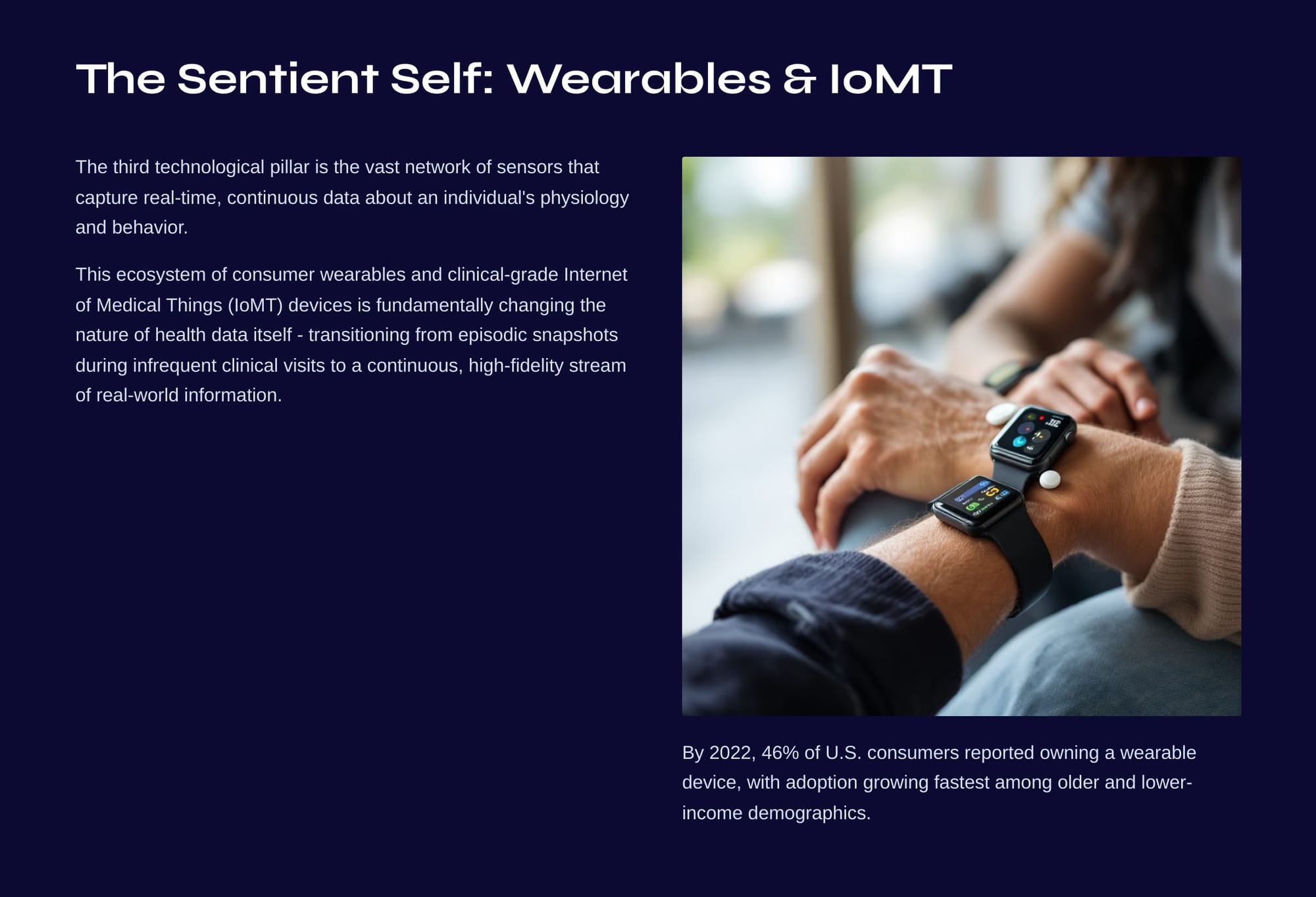
Tying it all together will be the emergence of a health “Super-App” - a single, integrated digital platform that serves as the primary interface for an individual’s entire health journey. This allows for:
- Virtual Consultations: On-demand access to healthcare providers through secure video calls.
- AI Health Coaching: Personalized wellness advice and behavior change support.
- Medication Management: Prescription ordering, reminders, and delivery services.
- Health Records: Comprehensive personal health data and insurance management.
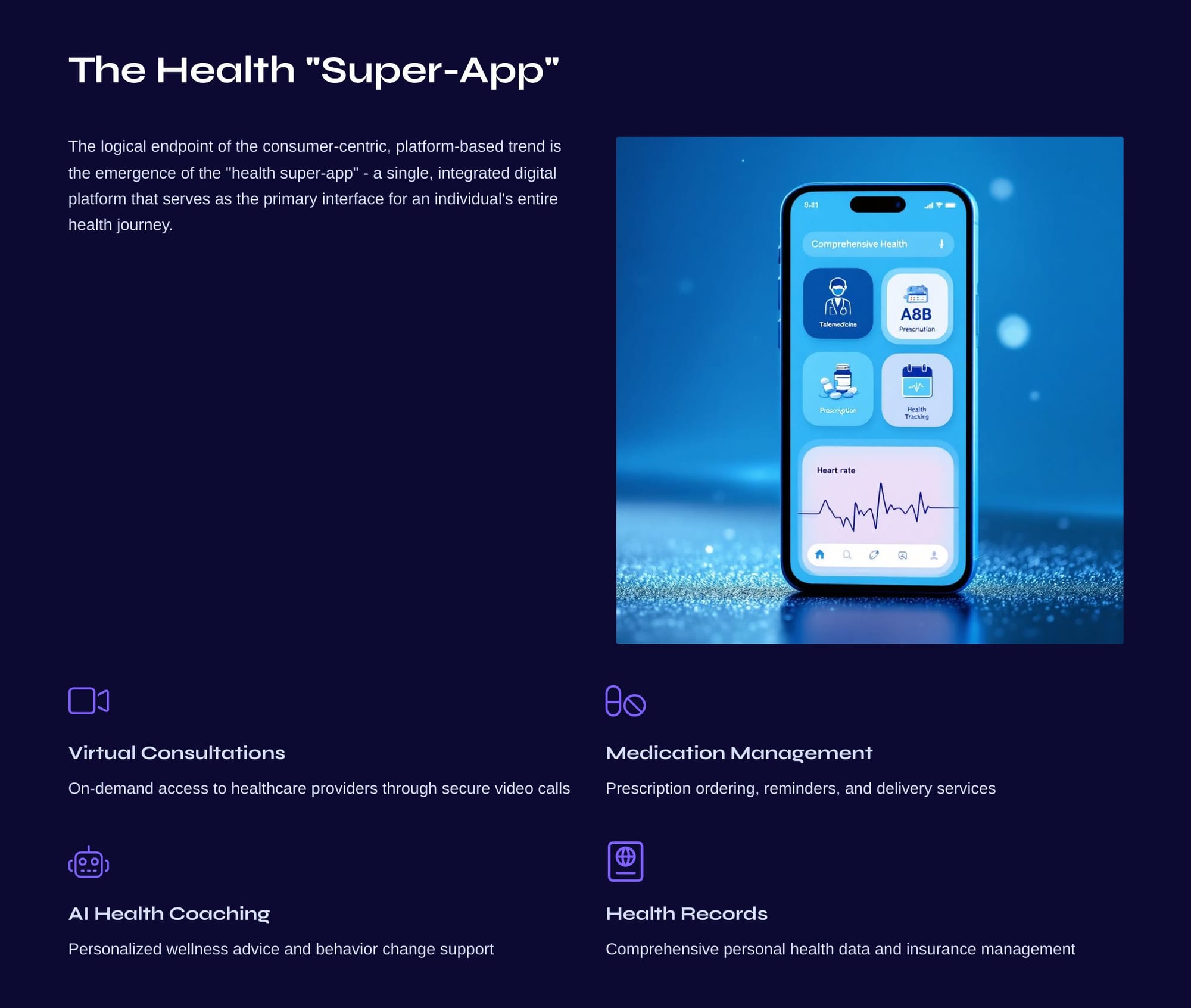
Last but not least, add into the mix the digital pharmacy, often referred to as digital therapeutics (DTx). This trend involves evidence-based, software-driven therapeutic interventions designed to prevent, manage, or treat medical disorders. Think of it as all the data from the above trends coming together for real-time monitoring that leads to 'drug treatment on demand.' Or, just-in-time pharmaceuticals! The global DTx market is projected to reach between USD 56-90 billion by 2034, with a sustained CAGR of over 21%.
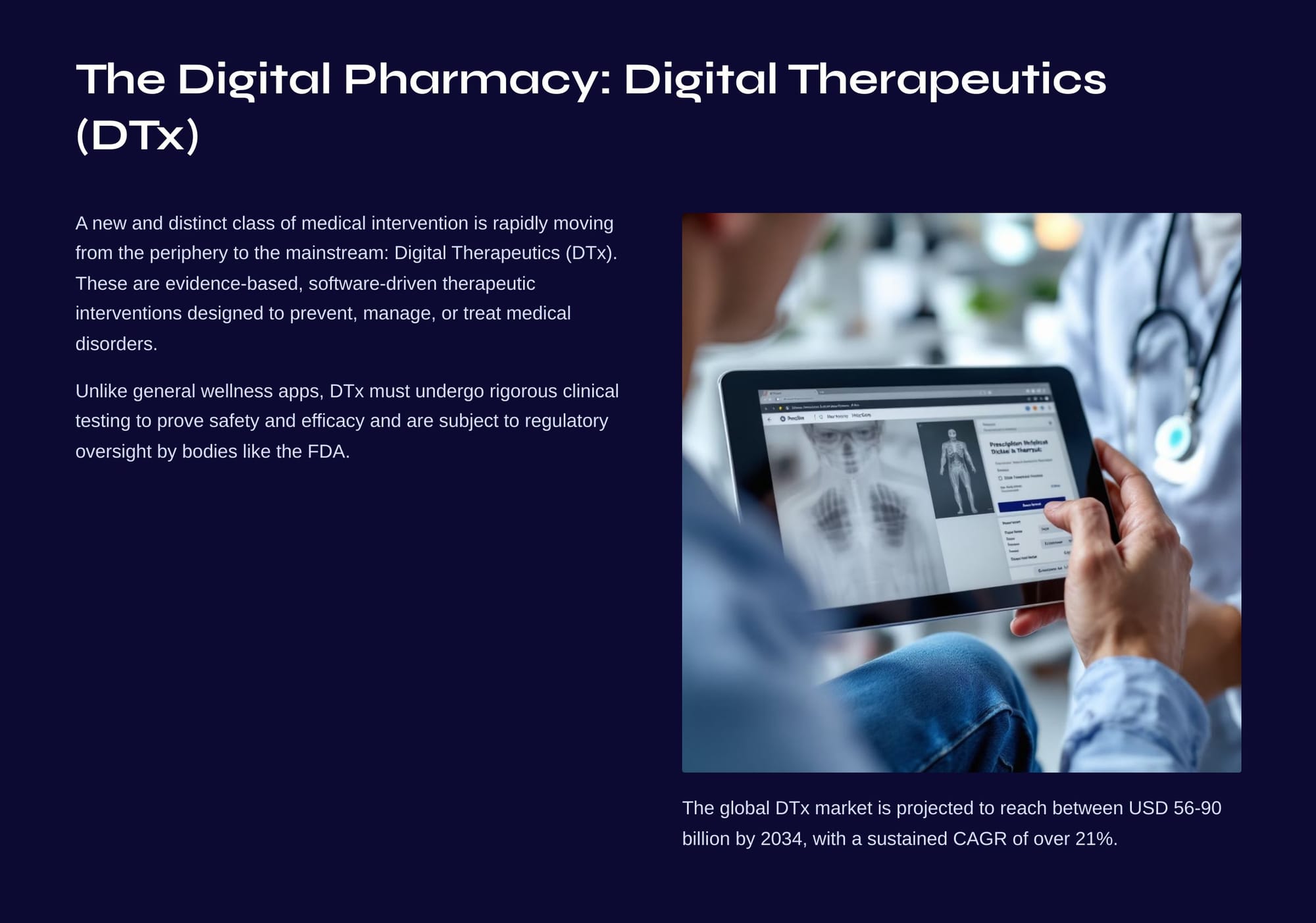
Key to making all this work will be the evolution of the "patient as a partner", which will involve huge behavioral shifts and doctor-patient engagement. All of these changes are dependent on the idea of the patient as an active, engaged partner, not a passive recipient of care. This requires a deep understanding of evolving patient behaviors, their willingness to adopt new technologies, their attitudes toward data sharing, and the factors that drive or inhibit their engagement.
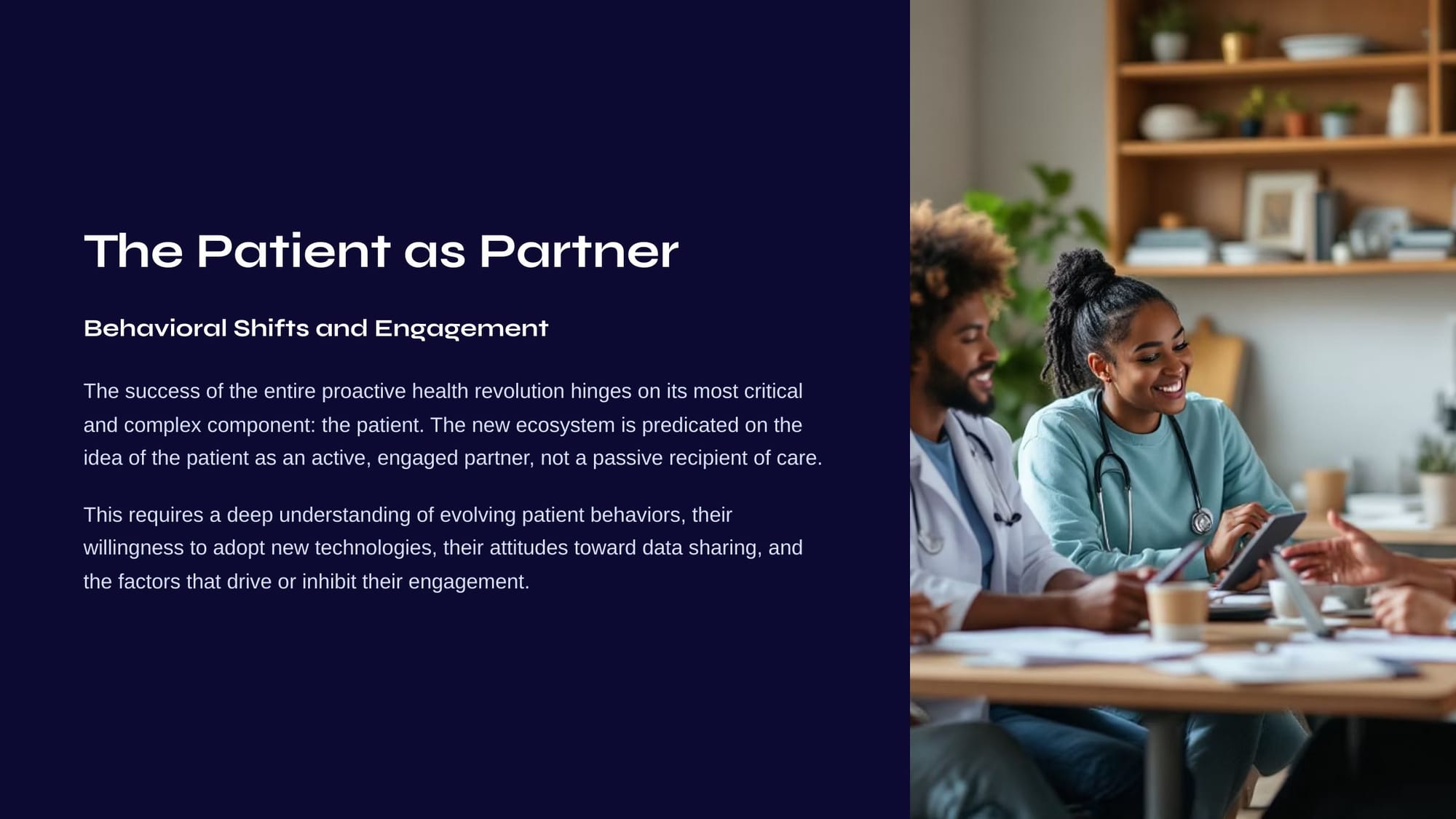
They will allow for remote patient monitoring, becoming a truly proactive patient.
The opportunities here for patients living with chronic conditions are significant because they are empowered to become active participants in their care. A growing body of research demonstrates that RPM programs significantly decrease emergency department visits, reduce the length of hospital stays, and prevent costly readmissions. The technology is particularly effective for managing conditions like hypertension, diabetes, heart failure, and COPD. Patient satisfaction with well-run RPM programs is consistently high, with one large study finding that 93.6% of participants were pleased with their experience.
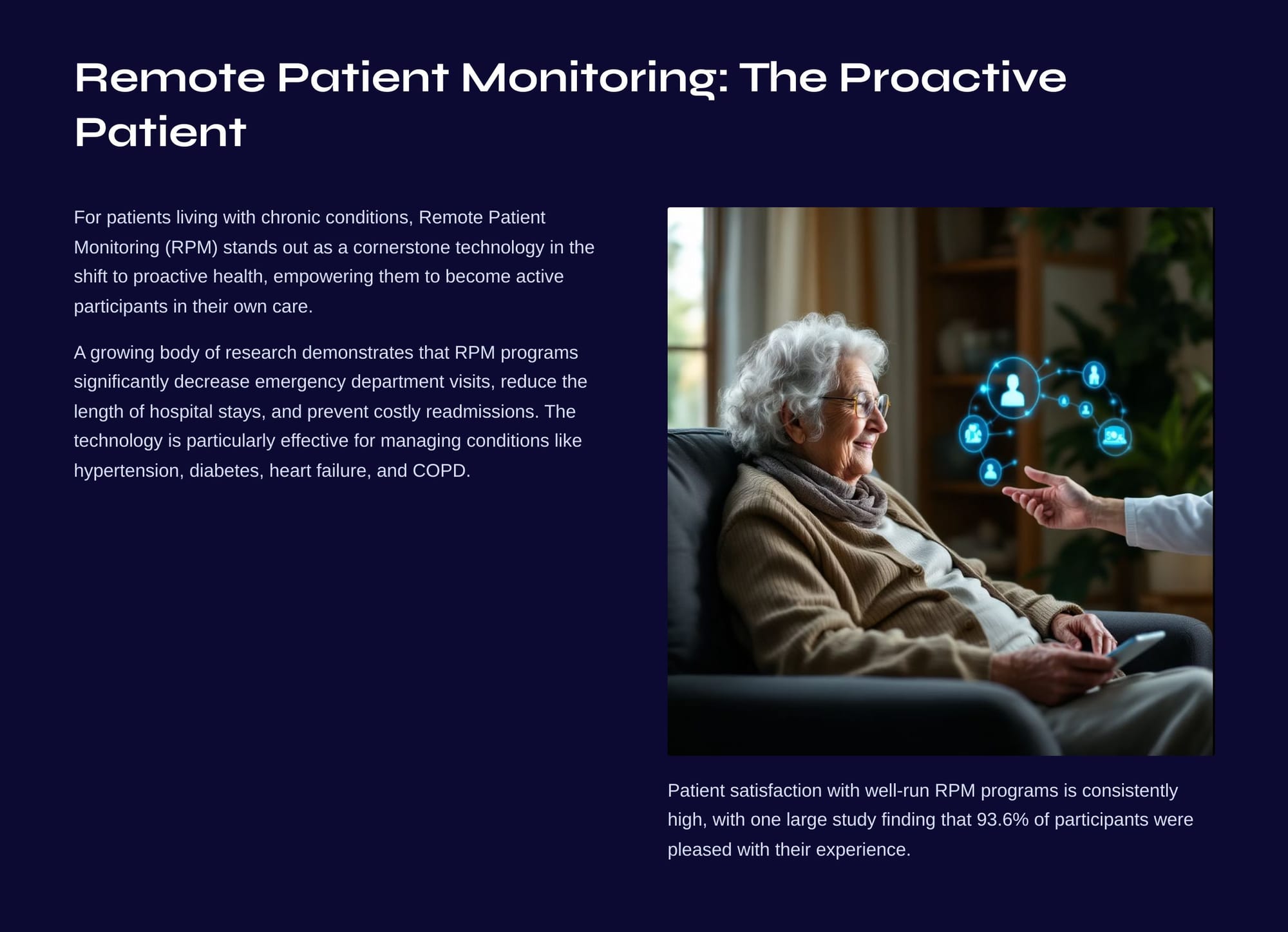
That said, the benefits are tremendous, leading to some fundamental, systemic changes. Some believe the end game is this:
- The Patient Experience: Health status continuously monitored by biosensors in wearables, home environment, and clothing. Personal “Health AI” agent provides real-time coaching and detects subtle deviations from baseline. The care team proactively reaches out when risk is identified rather than waiting for symptoms.
- The Provider Experience: Primary care physicians transform from reactive problem-solvers to proactive health managers. The day begins with an AI-prioritized dashboard highlighting high-risk patients. Interdisciplinary teams execute coordinated outreach, with most interventions handled remotely and in-person visits reserved for complex cases.
- The System: Healthcare operates almost entirely on a system that ties payments to outcomes. Hospitals evolve into lean centers for high-acuity interventions, while chronic disease management and wellness support are delivered remotely. Data flows seamlessly between all stakeholders, governed by patient-controlled consent.
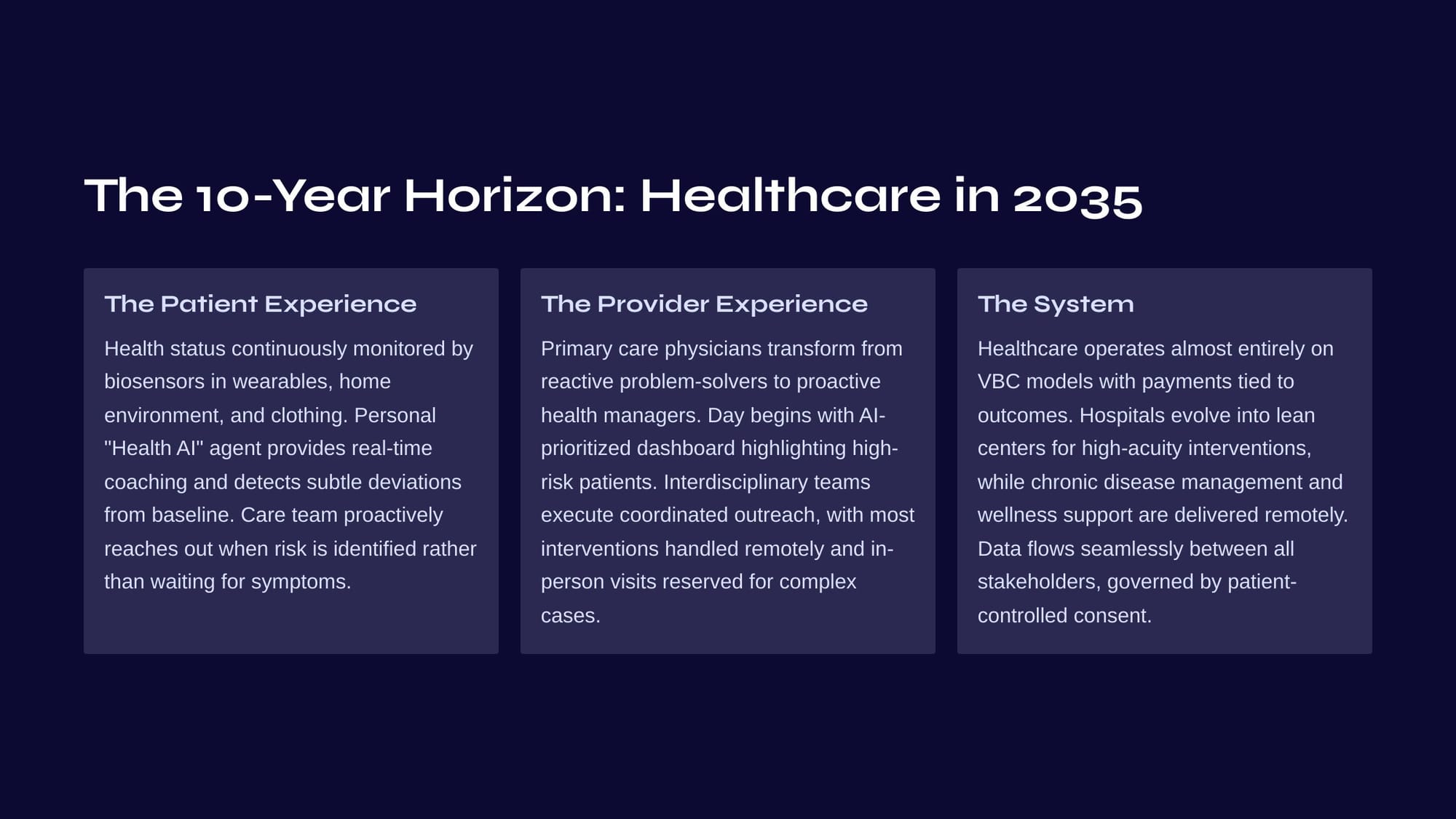
Will all of this happen?
There's a lot of pie-in-the-sky thinking that involves huge change with a massively complex system. Some societies are no longer mature enough to chase the opportunities.
But the trends, technology, and science identified above are evolving at an astonishing speed, and so clearly, this is a megatrend to watch.
Futurist Jim Carroll has been covering the trends in this article throughout the global healthcare sector for 20+ years. More details can be found at healthcare.jimcarroll.com

